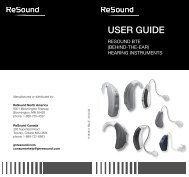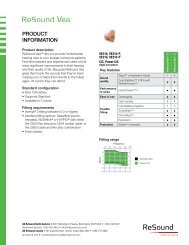ReSound Vea Behind-the-Ear (BTE) User Guide
ReSound Vea Behind-the-Ear (BTE) User Guide
ReSound Vea Behind-the-Ear (BTE) User Guide
You also want an ePaper? Increase the reach of your titles
YUMPU automatically turns print PDFs into web optimized ePapers that Google loves.
Getting started<br />
On/Off function<br />
1. When <strong>the</strong> battery door is closed, <strong>the</strong> hearing instrument<br />
turns on, and <strong>the</strong> default program will be activ ated.<br />
2. To turn off <strong>the</strong> hearing instrument,<br />
open <strong>the</strong> battery door.<br />
Many individuals can use <strong>the</strong>ir<br />
fingernail to pull it open.<br />
Tip: Whenever <strong>the</strong> hearing<br />
instruments are not in use,<br />
remember to turn <strong>the</strong>m<br />
off to avoid unnecessary battery<br />
consumption.<br />
smartstart<br />
Hearing instruments can be turned on once you have placed<br />
<strong>the</strong>m on your ears. If you prefer to turn <strong>the</strong>m on just prior to<br />
placing <strong>the</strong>m on your ear, your hearing care professional can<br />
activate a function called SmartStart. This function will delay <strong>the</strong><br />
time in which <strong>the</strong> hearing instruments turn on by ten seconds<br />
after <strong>the</strong> battery compartment is closed. This reduces <strong>the</strong> risk<br />
that <strong>the</strong> hearing instruments will whistle while you put <strong>the</strong>m on..<br />
With SmartStart, a beep will be heard for each second of <strong>the</strong><br />
delay period.<br />
inserting/replacing <strong>the</strong> battery<br />
3. Open <strong>the</strong> battery door completely<br />
by using your fingernail.<br />
4. Remove <strong>the</strong> used battery if present.<br />
Insert <strong>the</strong> new battery with <strong>the</strong> positive<br />
side in <strong>the</strong> correct position. The<br />
battery door has a ‘+’ indicator to help<br />
determine <strong>the</strong> correct insertion.<br />
5. Always use new Zinc-Air batteries that have a minimum<br />
remaining shelf-life of 1 year.<br />
6. Gently close <strong>the</strong> battery door.<br />
Tip: When <strong>the</strong> hearing instruments are not in use for an<br />
extended period of time, removing <strong>the</strong> batteries may help<br />
prevent corrosion of <strong>the</strong> battery compartment, and ensure<br />
that battery life is not shortened.<br />
low battery indicator<br />
Your hearing care professional can set your hearing instrument<br />
to give an acoustical indication when <strong>the</strong> battery is<br />
reaching its end of life . The hearing instrument will reduce<br />
amplification and emit a melody if battery power gets too low.<br />
This signal will recur every five minutes until <strong>the</strong> hearing instrument<br />
automatically switches off. It is recommended that you<br />
keep spare batteries on hand.<br />
inserting/removing hearing instruments<br />
Insertion (custom earmolds)<br />
1. Hold <strong>the</strong> earmold between your thumb and index finger<br />
and position its sound outlet in your ear canal.<br />
2. Slide <strong>the</strong> earmold all <strong>the</strong> way into your ear with a<br />
gentle, twisting movement.<br />
3. Turn <strong>the</strong> top part of <strong>the</strong> earmold gently backwards and<br />
forwards so that it tucks behind <strong>the</strong> fold of skin above<br />
your ear canal.<br />
4. Move <strong>the</strong> earmold up and down and gently press to<br />
ensure it is positioned correctly in <strong>the</strong> ear. Opening and<br />
closing your mouth can ease insertion.<br />
5. Make sure <strong>the</strong> hearing instrument is seated behind <strong>the</strong><br />
ear.<br />
By experimenting, an easier method may be discovered.<br />
With proper insertion, hearing instruments should fit snugly<br />
but comfortably. If hearing instruments cause irritation<br />
of <strong>the</strong> ears, contact your hearing care professional. Never<br />
attempt to modify <strong>the</strong> shape of <strong>the</strong> hearing instrument, earmolds,<br />
or tubing yourself.<br />
Tip: It may be helpful to pull your ear up and outward<br />
with your opposite hand during insertion.<br />
10 11





